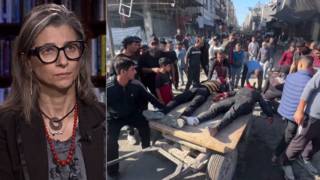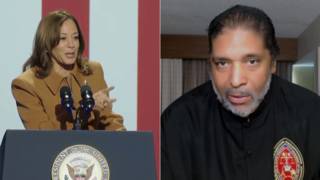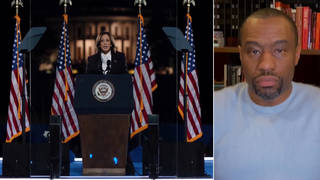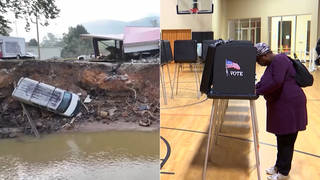
Related
Guests
- Paul Ortizprofessor of history and director of the Samuel Proctor Oral History Program at the University of Florida.
- Julia Wrightdaughter of Richard Wright.
In Part 2 of our our interview about the 103rd anniversary of the 1919 Elaine massacre, which was commemorated this weekend, we continue our conversation with Julia Wright, daughter of the acclaimed Black author Richard Wright, who called Elaine home and wrote about his great-uncle Silas Hoskins’s lynching in Elaine three years prior in 1916. We also speak with Paul Ortiz, historian at the University of Florida, about one of the worst racial massacres in U.S. history, when white mobs in Arkansas killed over 200 African Americans. After the massacre, no white attackers were prosecuted, but 12 Black union members convicted of riot-related charges were sentenced to death. The NAACP challenged their conviction, and in a landmark case, the Supreme Court ruled 6 to 2 that their 14th Amendment right to due process had been violated, leading to their release.
Transcript
AMY GOODMAN: This is Democracy Now!, democracynow.org, The War and Peace Report. I’m Amy Goodman, as we turn to Part 2 of our interview about this 103rd anniversary of the Elaine massacre, commemorated this past weekend in Arkansas.
Before the massacre, Elaine was home to Richard Wright, who became one of the most famous Black writers in United States history. He was known for his acclaimed novel Native Son and his memoir, Black Boy, in which he describes how his uncle Silas Hoskins was lynched in 1916 near Elaine by white people who wanted his business. Richard Wright was 9 years old when he and his family were forced to flee. He wrote, quote, “There was only silence, quiet weeping, whispers and fears. Uncle Hoskins had simply been plucked from our midst and we, figuratively, had fallen on our faces to avoid looking into that white-hot face of terror that we knew loomed somewhere above us. This was as close as white terror had ever come to me and my mind reeled. Why had we not fought back, I asked my mother, and the fear that was in her made her slap me into silence.” Richard Wright was describing a true story.
Three years later, on September 30th, 1919, a white man was shot and killed near Elaine when guards stopped a group of white men from breaking into a meeting of Black sharecroppers with the Progressive Farmers and Household Union of America to demand fair pay for their crops. Mobs of white people responded in Elaine, Arkansas, with three days of anti-Black racist violence, backed by hundreds of U.S. soldiers. Historians estimate hundreds of Black people were killed, much of their land stolen. The anti-lynching journalist Ida B. Wells investigated the 1919 Elaine massacre and wrote, quote, “Negroes were in a fair way to become independent and it was not to the interest of white landowners to let them do so.”
For more, we continue with Julia Wright, the daughter of the literary giant Richard Wright, and she is in Portugal. We’re also joined by Paul Ortiz, professor of history and director of the Samuel Proctor Oral History Program at University of Florida, Gainesville. They were both part of symposium this weekend hosted by the Elaine Legacy Center and the Richard Wright Civil Rights Center. Professor Paul Ortiz is also author of the book, An African American and Latinx History of the United States.
We welcome you both to Democracy Now! Professor Ortiz, let’s begin with you, because, I mean, you’ve written this African American and Latinx History of the United States, so much of which is not included in the standard history books that children in the United States grow up with. I mean, the Elaine massacre, and the commemoration this weekend, hardly got paid attention to. Can you talk about why it’s so important to remember something that happened in 1919?
PAUL ORTIZ: Amy, it’s so important for a number of reasons. You mention, you know, Latinx history. And this summer I was in the National Archives doing research. The same situation that faced African American farmers, and whether they were landowners or sharecroppers, faced Mexican and Puerto Rican farmers and sharecroppers in the Southwest. The same forces of state violence were targeting Mexican farmworkers and farmers in the Southwest. Now, the face of that violence was law enforcement and the Texas Rangers. What they were doing was disenfranchising Mexican American farmers, lynching, committing horrific acts of violence, to keep Mexican farmers landless, to keep them powerless, the same way that federal troops and law enforcement in Arkansas colluded to keep African American farmers powerless and landless, to keep them as a landless proletariat.
And when you begin to kind of put those pieces together, it adds up to a picture of American history, Amy, which most historians are very uncomfortable with. We’re used to thinking of the U.S. as the freest country on Earth. But how do you square that with the Elaine massacre of 1919?
AMY GOODMAN: And for those who haven’t heard the first segment of our show, if you could summarize what happened in 1919?
PAUL ORTIZ: African American farmers, sharecroppers, tenant farmers, landowners were beginning to organize. Many of those African Americans, Amy, who were targeted for violence by white people were actually World War I veterans. They had served in the United States Army. And when they returned to the Arkansas Delta, when they returned to rural Alabama, when they returned to rural Florida and other parts of the South, they expected equal citizenship. They had just made huge sacrifices to help win the Great War for Democracy, as it was known. But when they begin trying to purchase more land, purchase more land for their crops, try to get higher prices for their cotton, whether they’re sharecroppers or landowners, the white power structure in places like Helena, Arkansas, fought back and began to engage in vigilante violence. But, Amy, one of the things I want to point out here is the term “vigilante violence” is probably overused, because the reality is that the courts, judges, sheriffs, police, federal troops were involved in suppressing African Americans, keeping them landless, keeping them powerless. But Black people fought back.
And you mentioned Ida B. Wells-Barnett. She was a great crusader against lynching, you know, years before the Elaine massacre. She wrote an amazing exposé of the Elaine massacre and really gave voice to African Americans who had been brutally tortured, had been driven off their land. Ida B. Wells created an itemized list of the property that African Americans lost as a result of the Elaine massacre, including land, including cotton, including the fact that white people went into Black-owned houses and stole their kitchen, their cutlery, their china, everything they could get their hands on, Amy. And none of those white perpetrators were ever charged with any crime whatsoever. And this really outraged Ida B. Wells. And if you know anything about her, you know that once she got onto a campaign, she continued investigating, but also mobilizing. She went back to Chicago. She went to New York.
And also, this, the Elaine massacre, part of the aftermath was to help the NAACP gain greater credibility, because Walter White did his own investigation. The NAACP helped mobilize people. There was a huge defense fund. So, the Elaine massacre resulted in a national mobilization in support of African Americans who had been put in jail, who had been tortured, who had been convicted of murder, in fact, when they themselves were the targets of violence.
AMY GOODMAN: And you also spoke about this in the first part of our discussion, but now you have time to really flesh it out, the fact that this massacre led to a seminal Supreme Court case. And talk about what was decided. I mean, again, no white people were charged. It was African Americans that were charged in this case?
PAUL ORTIZ: Yes. So, there were five — as best as we can tell, five white individuals were killed during the course of the massacre, which unfolded not just in one day but over several days and even weeks. So, the defendants, the men who were actually incarcerated, charged with murder, these were all African Americans. But much of that testimony, Amy, was coerced. These men were literally electrocuted. They were whipped. They were beaten savagely in order to coerce them into testifying against each other.
This is something that Ida B. Wells highlighted. The fact that Ida B. Wells wrote a report about what she had witnessed, and based on the testimony of these Black defendants, the fact that the NAACP did an investigative report, the fact that the local Black attorney Scipio Jones, who was a Black legal activist for decades, the fact that they publicized this case really embarrassed not just the criminal justice system in Arkansas but the entire nation, because there’s old traditions that go back to the common law which say that you’re not supposed to use testimony which was coerced via torture.
And so, the Moore v. Dempsey case, this goes all the way to the Supreme Court. And what the Supreme Court decides in Moore v. Dempsey is that the trial of the 12 Black defendants was conducted in a lynch mob atmosphere. And in the majority opinion, what the majority of this Supreme Court said was, I mean, look, not a single white person on that jury — and by the way, the jury was all white, and this was part of what the NAACP was arguing was part of the injustice. But the Supreme Court said, basically, not a single member of that jury could have returned anything other than a guilty verdict against those Black defendants, because had any one of those jurors said that any one of those Black defendants was innocent, they would have had to leave the state, literally. And so, the argument in Moore v. Dempsey is that you can’t have a court proceeding in a lynch mob type of atmosphere, because you’re denying the defendants due process, you’re denying them equality under the laws, and those types of things. So, Moore v. Dempsey becomes an important case for the NAACP to build upon, and it becomes a precedent that the organization uses as we move into the Scottsboro Boys case during the Great Depression, and the later civil rights movement.
AMY GOODMAN: Earlier this year, children of the descendants of the 1919 Black massacre in Elaine, Arkansas, gathered memorial soil from where Richard Wright’s uncle, Silas Hoskins, was thought to have been lynched, near Elaine, and they brought it to Montgomery to the National Memorial for Peace and Justice, the national lynching memorial in Montgomery, Alabama, where founder Bryan Stevenson personally received the jar of memorial soil.
BRYAN STEVENSON: We have Silas Hoskins, Elaine, Arkansas, 1916. And this is a significant one because Silas Hoskins was the uncle of Richard Wright, the very famous author, who wrote amazing books. And Richard Wright talked about what happened to his uncle, and that’s how we know his story. And because you have these two jars, we will be able to put them in our exhibit, and I’m really grateful for that. And so, if you will turn that over, I will take it, and we will put this in our museum. And the next time you come, you’ll be able to see the work that you’ve done. All right? Thank you. Thank you, thank you, thank you.
AMY GOODMAN: So, that’s children of the descendants of the Elaine massacre victims, handing jars of soil to the great civil rights leader Bryan Stevenson, which brings us to Julia Wright, the daughter of Richard Wright, the acclaimed writer who lived there in Elaine. Can you talk about this moment, the memorial that is happening now, and what happened then, Julia?
JULIA WRIGHT: It was absolutely — I have no words for what happened. We were watching through Zoom, because the family couldn’t travel. And we watched those 12 children with their hands in the soil. And Dr. Mary Olson, who’s the director of the Elaine Legacy Center, was telling them, “Your hands will be forever on that soil.” And just the idea of those children, who are survivors, bringing the soil, the memorial soil of my own great-uncle, was like the closing of a circle. And it made me think a lot about intergenerational trauma and how it’s handed down, and how it’s prevented from being handed down, by silence. And what struck me, Amy, on Friday, listening in to the symposium and to the descendants speaking, is that they were all breaking that silence. They were speaking their own narratives, and the joy of being able to break silence, to break — you know, that sentence my father has in Black Boy, my mother — the fear my mother had slapped me into silence. She slapped me into silence, she was so afraid. And what happened on Friday in Elaine was a reversal of that. Everybody was breaking through their own silence with their own narratives.
And that is why it’s so appropriate to have Paul Ortiz here today, because Paul Ortiz is an oral historian who gives value to — how can I say? — oral testimony, not written testimony, the oral, the words that we can say when we break through our silence. And I know — I can remember Noelle Hanrahan, the director of Prison Radio in Philadelphia, telling me that everybody in Philadelphia knows how corrupt the police are, but what the criminal justice system doesn’t want is it to get into the written record. It must remain unsaid. It must remain part of the silence. So, our oral testimony is our voyage towards getting it written. And the work of Paul Ortiz and all the oral historians is invaluable.
AMY GOODMAN: Paul, let’s talk about that issue of oral history, who gets documented and who doesn’t, as it relates to Elaine and so much more. It is what you are a master of. You are running an entire program called the Samuel Proctor Oral History Program at University of Florida, Gainesville.
PAUL ORTIZ: Well, Amy, one of our — one of the greatest honors that I’ve ever had as an oral historian, of course, is to be able to work with Julia Wright. And in 2019, the Elaine Legacy Center invited the Samuel Proctor Oral History Program and our students and staff to Elaine to help document this history. And what’s so important is, you know, I think, as historians, we — any type of source we can get, we’re going to use. To echo what Julia Wright said, the oral sources are so important because oftentimes the official sources were created by the perpetrators of anti-Black violence. Oftentimes the official sources were created by the perpetrators of anti-Mexican violence.
This is why the work of Ida B. Wells is so important. I would consider her one of the first great oral historians, and maybe the greatest oral historian in this country’s history, Amy, because Ida B. Wells went behind the official sources to talk directly to the families of those who had been lynched. She went to Elaine. She talked directly to the victims of torture, of persecution. And so her narrative is radically different than the narrative of the front page in The New York Times, Amy. Their response to the Elaine massacre initially was that Black people had been involved in a plot to kill all white people. That ran on the front page of The New York Times. So, the work of Ida B. Wells as oral historian is to go behind that story and actually dig to find the truth.
This is what we try to do in the Samuel Proctor Oral History Program today. We’re involved with communities in Elaine and also in communities in Ocoee, Florida, which suffered a horrific anti-Black massacre on Election Day in 1920. We have done work in Rosewood, Florida. We’ve done work in our own county, Alachua County.
AMY GOODMAN: The massacre in Rosewood.
PAUL ORTIZ: Yes, in the massacre in Rosewood. But the thing I think to remember, as Julia knows, the Elaine massacre is horrific, but it’s one of many, scores, perhaps hundreds, of massacres. It happens during Red Summer. And it happens during a time when especially African American farmworkers and farm owners are trying to create new ways of becoming economically viable. They’re going to cooperative purchasing and marketing of their crops. They’re beginning to unionize. And they’re beginning to try to break through the system of white supremacy.
And I think the Elaine Legacy Center has really nailed it when they talk about Elaine as being really one of the key founding places of the civil rights movement, because even though the Elaine massacre ends up in this horrific — these horrific incidents of anti-Black violence and murder, there’s a power that Black people find in collective organizing, and they refuse to allow the victims of the Elaine massacre to be — to go away silent.
AMY GOODMAN: Speaking of hearing the voices that Professor Ortiz is just talking about, I want to go back to Julia Wright. I want to go back to Elaine and Richard Wright, where Richard Wright lived as a child. I want to go to the clip from the Emmy Award-winning film, Richard Wright: Black Boy, the first documentary on Richard’s life, work and legacy.
AMIRI BARAKA: It was Wright who was one of the people who made me conscious of the need to struggle. You understand what I mean? Even though later I come up and say, “Well, man, I don’t agree with that. I don’t agree with that.” Still, in the sense of him describing and analyzing the whole existence of Black people as an oppressed nation, that’s priceless.
RICHARD WRIGHT: I was scared. Scared! All my life, I heard of Black men being killed because of white girls. And there I was.
JOHN HENRIK CLARKE: Richard Wright proved that a Black writer could write considerably better than most of the white writers of his day. And after Native Son, the condescending attitude toward Black writers was over.
MARGARET WALKER ALEXANDER: He said, “Nothing comes before my art.” For him, his art was sacred. He didn’t care about anything else but that. What he had to do was the most important thing.
AMY GOODMAN: The clip from Richard Wright: Black Boy. Julia Wright, if you can talk more about what they are getting at and the power of your father’s work? Of course, you’re the executor of his estate.
JULIA WRIGHT: Well, it stands the test of the murder of George Floyd. It stands the test of the denied justice to Emmett Till for 67 years. His work is more — I don’t know, maybe I can use the word; it’s a bit cheesy, but — prescient than ever. My father did see very far ahead. He paid the price for it.
But I’d like to come back to something absolutely marvelous that I discovered because of what happened Friday in Elaine and seeing all these guests singing and speaking and breaking their silence, that actually Black Boy was born from that very breaking of a silence. In 1943, my father had traveled down South with Horace Cayton, who was a psychoanalyst — a sociologist interested in psychoanalysis. And they had gone to Fisk, where my father was invited to speak. But they were in the train, and on the train down South they experienced a racial incident. They were segregated behind a curtain. And my father, as usual, was very angry. And he arrived in Fisk without any notes written. He hadn’t written his lecture because he was so upset. And he advanced towards the lectern without anything prepared in advance. And he broke the silence of his mind, and he poured out his emotions, the emotions born on that train. And when the lecture ended, the whole room was so silent, you could hear a pin drop. And people started — it was a biracial audience. People started clutching their pocketbooks and leaving with their heads low. And one professor came up to him and said, “Wow, you’ve told the truth. Everybody’s leaving because you’ve told the truth.” And that’s when my father realized that he was going to write Black Boy.
AMY GOODMAN: Julia, I wanted to ask about — well, we’re speaking to you in Portugal now. We’ve spoken to you when you — you know, when you’re in Paris, France. Your father moved to France. If you can talk about how what has happened in the United States — I mean, you’re an American, but you live outside of the country, you come in occasionally — how it led you to live in Europe?
JULIA WRIGHT: Well, first of all, my father chose self-expatriation, and the whole family followed. We have remained loyal to that choice.
However, Amy, this lynching goes on everywhere in the world, because we are everywhere. We are a diaspora everywhere. And to go full circle back to the lynching memorial museum, I’ve been speaking with sisters and brothers in Europe about a need, perhaps, for their own lynching museum there. And I’ll only mention one case in Brussels, about a — they call him the Belgian George Floyd. He was choked in very much the same manner. And his family, who are very poor — he’s an African. His family, very poor, decided to question his manner of death. And much pressure was put on the state to dissuade them from questioning the murder, but the father persisted. And so, the body had to be put in the morgue. And during the time of the trial, the body stayed in the morgue, because that’s the law. And it is the family who had to pay 25 euros a day to the morgue, to the state, because they had dared question the manner of murder.
So, it’s everywhere, Amy. And just as Paul Ortiz was saying that perhaps survivors of massacres throughout the country should unite and exchange experiences, and even have massacre reunions — there’s a whole hidden map of massacres, we could link up — in the same way, there are lynchings throughout the world we must pay attention to.
AMY GOODMAN: And before we end, if you could talk more about the Elaine Museum in Arkansas that held the memorial 103 years after the Elaine massacre, and the Richard Wright Civil Rights Center, that is planning to be built in Elaine?
JULIA WRIGHT: I have not been there. It’s a wrench, Amy, but I — because of my age and COVID, I was unable to travel. It’s a work in progress. I am so proud. They invited me in Elaine to be a member of the Elaine Legacy Center, so I’m now a member. And it’s very exciting. We’re going to plan what the first initiative of the Richard Wright Civil Rights Center is going to be.
AMY GOODMAN: And —
JULIA WRIGHT: Maybe some — yeah?
AMY GOODMAN: And —
JULIA WRIGHT: Maybe something — yes?
AMY GOODMAN: Go ahead.
JULIA WRIGHT: Maybe mass incarceration.
AMY GOODMAN: And finally, the case of Mumia Abu-Jamal has been very close to your heart for many, many years. Can you talk about what’s upcoming in his case?
JULIA WRIGHT: A very important date, Amy: 19th of October is the date where he will appear in court in Philadelphia, where we hope to have a maximum of mobilization around the court, because, at last, after 36 years, the hidden boxes, where proof of his innocence were hidden in the prosecutor’s office storage room, will be submitted by the defense in front of a judge in the appeals court. They gathered dust for 36 years. In one of the boxes, there is a letter written by one of the witnesses, asking the prosecutor, “Where is my money?” There is further proof that the jury was tampered with, so that it would be all the Blacks would be stricken off. And other proof of corruption is contained in those boxes. But time is ticking. The proof was hidden. And Mumia’s health is deteriorating.
AMY GOODMAN: Well, Julia Wright, I want to thank you so much for being with us, daughter of the literary giant Richard Wright, and she herself a writer, a poet in her own right. I want to thank you for being with us, today joining us from Portugal.
JULIA WRIGHT: Thank you.
AMY GOODMAN: And I want to thank Paul Ortiz, professor of history, director of the Samuel Proctor Oral History Program at University of Florida, joining us from Raleigh, North Carolina, where he’s giving a Hispanic heritage speech at Duke University. Professor Ortiz is author of the book An African American and Latinx History of the United States. To see Part 1 of our discussion, you can go to democracynow.org. I’m Amy Goodman. Thanks so much for joining us.












Media Options